SEO is the key to unlocking your website’s potential and ensuring it ranks high in search engine results. Whether you’re a digital-age business owner or a website developer, it’s important to stay up-to-date on the latest SEO trends and statistics.
In this guide, we’ll share some important SEO statistics that you can apply to your own strategies in 2025 and beyond.
We’ve categorized these statistics into different areas, so that you can just focus on the topics that are relevant to your needs.
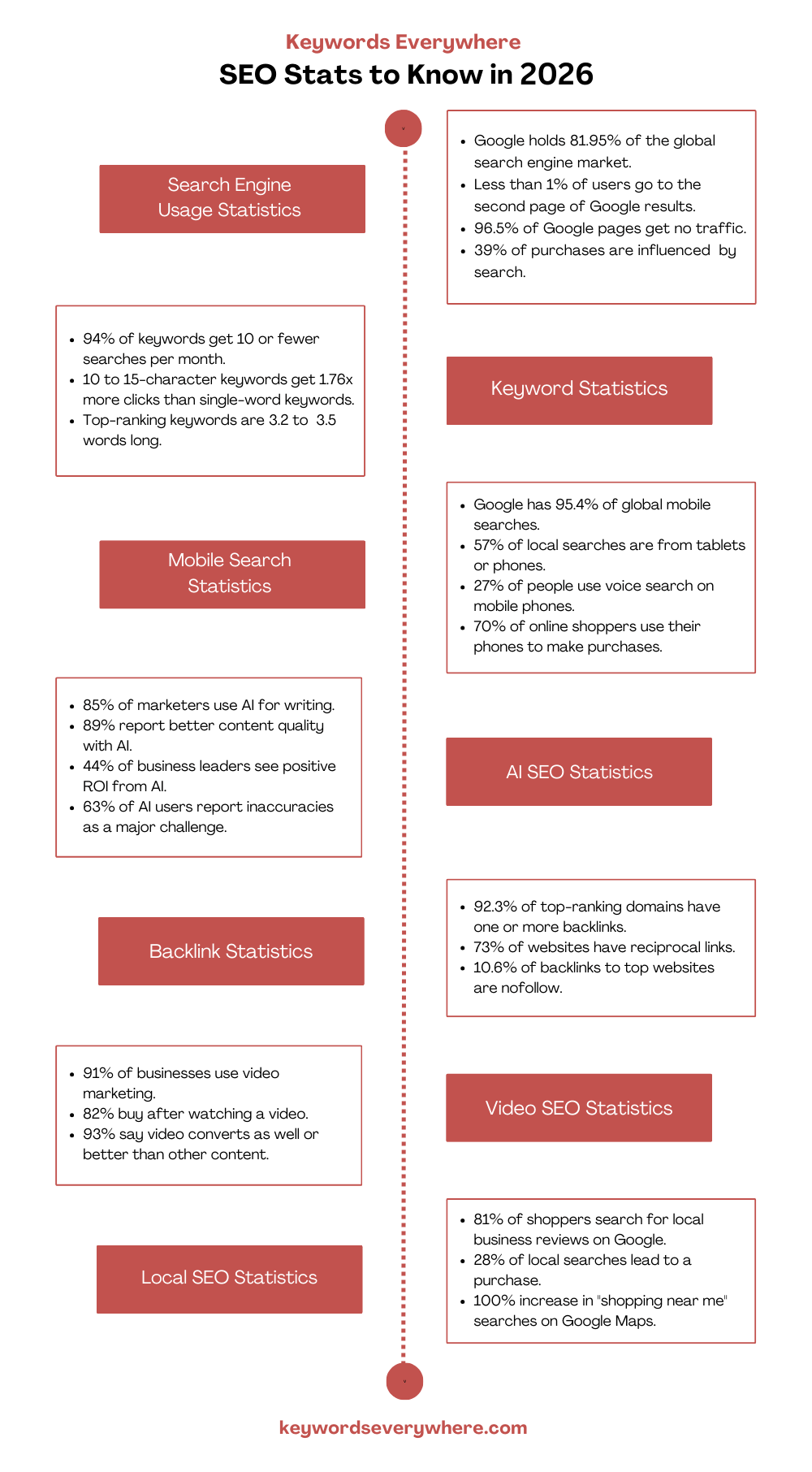
Search Engine Usage Stats
Search engine is to SEO what water is to life. Without search engines, SEO wouldn’t exist. Knowing how people use search engines can give us insights into how we should optimize our websites.
1. 68% of all online experiences can be traced back to the search engine as their initiating point.
2. Google dominates the search engine market, holding 81.95% of the global market share. In comparison, Bing accounts for 10.5% of the share, while Yahoo accounts for 2.67%.

Source
3. Google generated 84.2 billion visitors in December 2023, which indicates an evergreen growth for the search engine giant.
4. Google has a web index of around 400 billion documents.
5. Internet users make an average of 40,000 search queries per second on Google, which translates to more than 3.5 billion searches every day and 1.2 trillion searches a year.
6. 39% of all purchases made by Internet users are influenced by a search related to the product or service.
7. Less than 1% of people who use Google go to the second page of their search results, indicating the importance of ranking high in search engine results.
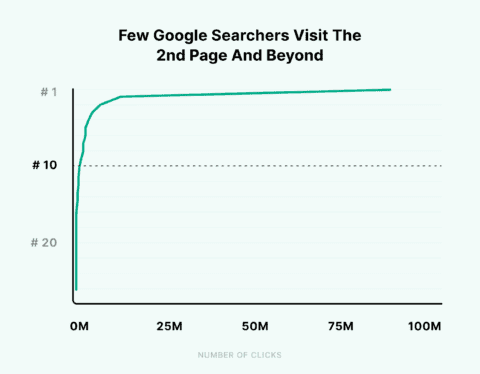
Source
8. Organic search is the top source of traffic for all websites.
9. Around 98% of shoppers read online reviews about local businesses. Besides Google Business reviews, people also turn to social media platforms, business websites, and third-party review sites for information about a company’s reputation.
10. Nearly 70% of shoppers go to the search bar on an online store’s website.
11. 96.5% of the pages on Google get no traffic from the search engine.
12. About 49% of the time, the top-ranking page on Google gets the most search traffic.
13. Featured snippets take up 50% to 65% of the first page’s real estate on Google.
14. On average, the first result on Google SERPs has a spam score of between 1% and 3%, with domain authority ranging between 85% and 95%.
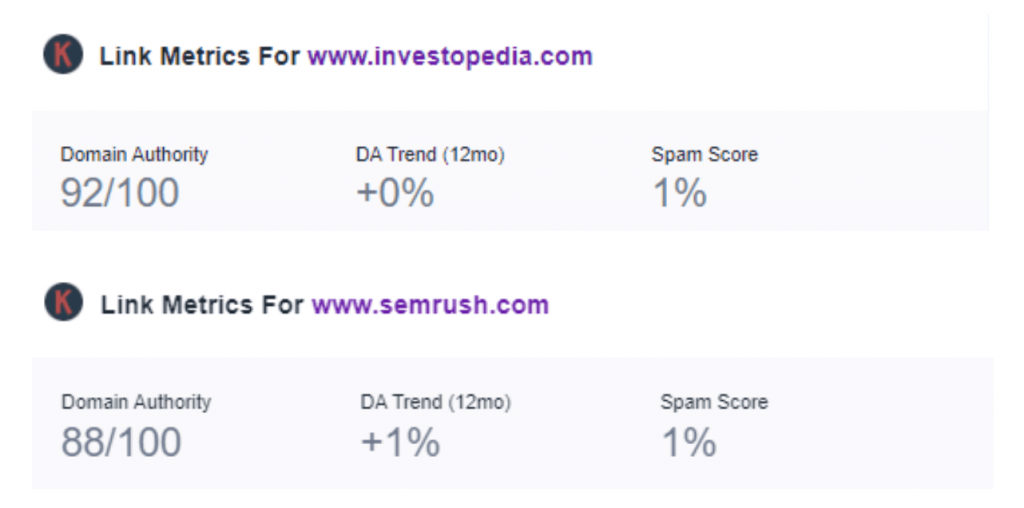
15. Google uses more than 200 factors in its algorithm to rank websites.
16. Around 49% of marketers say that organic search gives them the best return on investment (ROI) out of all marketing channels.
17. 49% of US customers use a search engine to start their search for a product when they shop online.
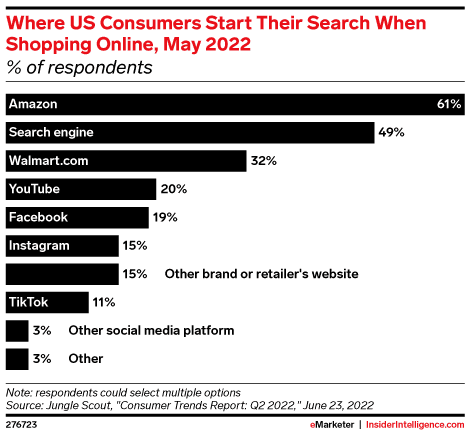
Source
18. About 60% of the pages ranking on top of the search engine results pages (SERPs) are three or more years old.
19. About 15% of all Google queries are novel, which means that they are new and have never been searched before.
20. ”YouTube” was the most searched term on Google in 2023, followed by ”Facebook.” The former had 340.28 million monthly searches while the latter had 238.52 million.
21. According to Keywords Everywhere data, on average, there are 4.4 fresh listings on Google SERPs.
22. The search for the term ‘’search engine optimization’’ is always in trend, with the most number of searches reaching 293,000 per week in July 2023.
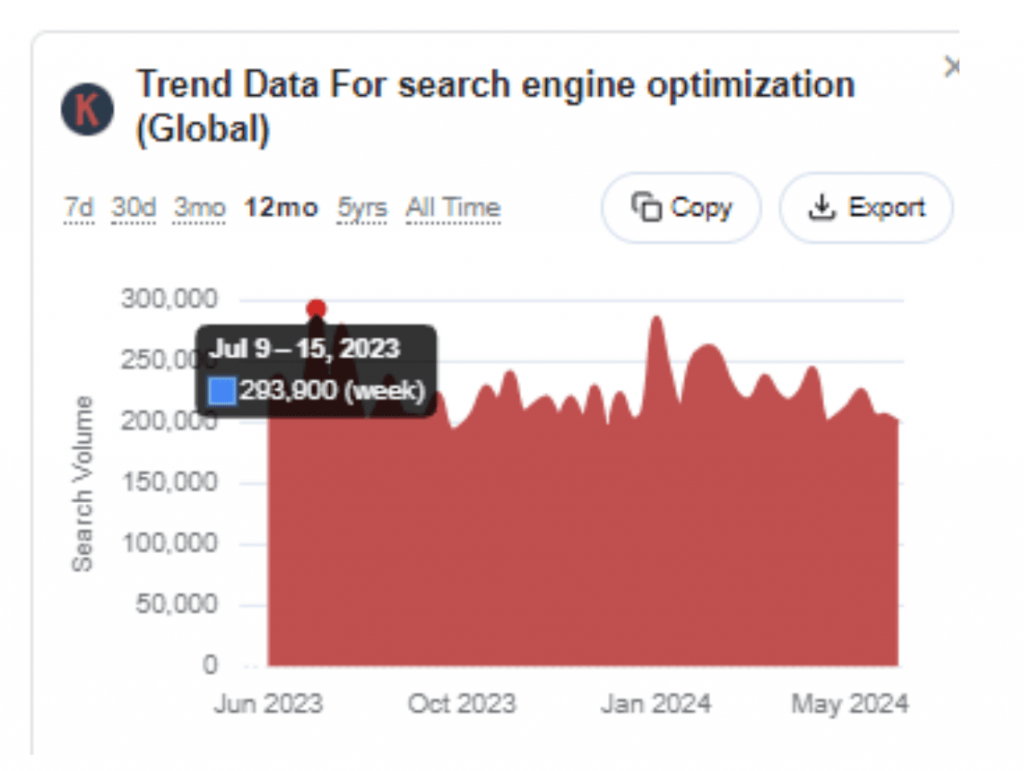
SEO Keyword Stats
Keywords are the backbone of search engine optimization (SEO) and play a significant role in determining a website’s ranking on search engine result pages. You can use keywords in your website content, title tags, meta descriptions, and URLs to optimize your website for search engines.
Here are some interesting keyword statistics that highlight the importance of using the right keywords in your SEO strategy.
23. Over 94% of keywords get ten or fewer searches per month. On the other hand, 0.0008% of keywords get over 100,000 searches per month.
24. The Google Keyword Planner is accurate only 45% of the time. About 54% of the time, the search volumes are overestimated.
25. SERP volatility, which measures how much the search results change, has increased in the past few years.
26. There’s no correlation between ranking high on the SERPs and using keywords in the title tag.
27. 10 to 15-character keywords get 1.76 times more clicks than their single-word counterparts.
28. The average length of the keywords that the top-ranking sites rank for is 3.2 to 3.5 words.
29. In the results for short-tail keywords, the top-ranking pages are now informational rather than transactional.
30. The search volume for AI keywords has spiked to over 100 million per month.
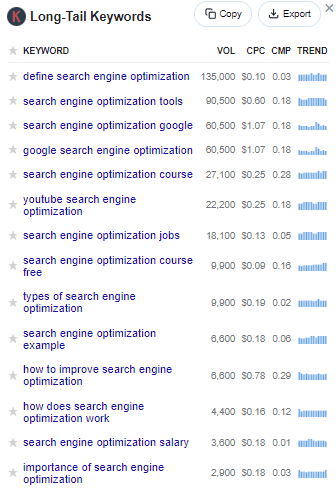
Mobile SEO Stats
SEO is no longer for desktops alone. Google’s mobile-first indexing means that websites will now be ranked based on their mobile SEO, too. So, it’s imperative to know how SEO works on mobile devices.
31. Google accounts for 95.375% of global mobile search engine searches. In comparison, Baidu, Yahoo, and Yandex account for under 1% each.
32. In the US, Google accounts for 95% of all searches. Google Search is also among the most popular search apps in the country, with 59% reach among mobile phone users.
33. About 57% of local search queries come from a tablet or a mobile phone.
34. More than 70% of online shoppers use their phones to make purchases online.
35. Google Lens is used by internet users to answer 8 billion questions per month.
36. 51% of mobile phone users discover a new product or company during their research.
37. 18% of local business searches on mobile phones result in a purchase within 24 hours, compared to 7% of non-local mobile phone searches.
38. 27% of the global population uses voice search on their mobile phones.
39. About half the US consumers use the voice search feature every day. The most common voice search queries are ”near” searches and information about the weather and news.

Source
Backlink Stats
A backlink is a link from one website to another. Backlinks are important for SEO because they indicate to search engines that your content is valuable and relevant, which can help improve your search engine ranking.
Before you start collecting backlinks, you should understand how these links impact your website’s performance. The following backlink statistics give some insight.
40. There’s an association between the search traffic of a web page and the number of backlinks it has. Pages with higher search traffic tend to have more backlinks.
41. 92.3% of top-ranking domains have one or more backlinks. More than half the qualified sites that do not have even one backlink do not reach the first page.

Source
42. About 73% of the websites have reciprocal links, which means that there is a mutual exchange of backlinks between two websites.
43. Web pages that have a lot of anchor text variations from internal links tend to get more Google search traffic.
44. Keywords Everywhere data shows that the anchor text for backlinks received by most top-ranking pages is either a keyword or a statistic.

45. 10.6% of the backlinks to the top 100,000+ websites are nofollow, meaning they do not pass on any SEO value.
46. Paying for backlinks isn’t very effective since you only get 2 extra links per month this way.
SEO Specialists Recruiting Stats
You can either hire a full-time specialist or use the services of an agency to manage your website’s SEO. Some companies also opt for freelance specialists from sites like Upwork or Fiverr. Here are some statistics to consider while hiring SEO professionals.
47. While SEO professionals have different payment models, 78% of them have monthly retainers for full-service SEO or specific services.
48. 49% of the companies pay for external SEO services because it’s cheaper than doing it in-house. Of this, most (43%) pay an agency for their SEO services.
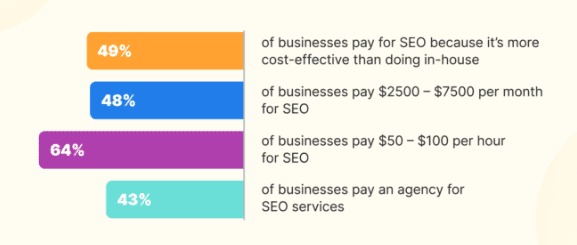
Source
49. The average base salary of an SEO specialist in the US is $64,892 per year.
50. SEO experts in South America, Central America, and India charge the least for their services.
51. The term ‘’hire SEO specialist’’ gets 1,300 monthly searches based on Keywords Everywhere data.

52. The median hourly rate of SEO experts on Upwork is between $15 and $35, depending on their experience and location.
53. Business owners spend anywhere from $500 to $10,000 per month on SEO services. That could also be $50 to $200 per hour or $1,000 to $10,000 per project.
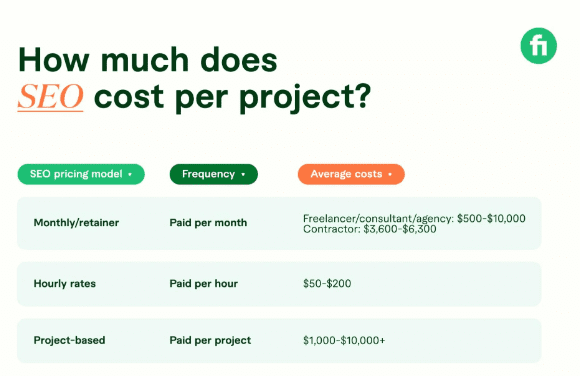
Source
54. Technical SEO experts earn more than other types of SEO experts. SEO leads and SEO heads are usually technical SEO experts.
55. Under 9.9% of SEO experts and agencies charge more than $150 per hour.
Video SEO Statistics
Video marketing has become increasingly popular in recent years, with businesses and individuals using videos as part of their marketing strategy. From Instagram Reels to TikTok videos and YouTube Shorts, there’s a demand for video everywhere.
The following statistics highlight the importance of incorporating video into your SEO strategy.
56. Over 91% of businesses use video as a marketing tool. It’s the highest percentage in the last six years, indicating a steady growth in video marketing.
57. Short-form video content format has the highest return on investment (ROI). It is followed by long-form videos, videographics, and webinars.

Source
58. 38% of marketing videos get less than 10k views on average, compared to 16% getting less than 1,000 views.
59. About 60% of marketers believe engagement to be the most important metric for measuring video success, followed by conversion rate at 56% and view count at 53%.
60. 39% of marketers use videos to improve brand awareness, while 31% use them for branding.
61. 93% of respondents in a survey said that video converts just like other content forms or better.
62. 80% of the sales teams realize that video creation should be integrated with sales engagement technology for best results.
63. Of all the video types, live-action is the most common, made by 48% of marketers. They are followed by screen recording and animated videos.
64. 82% of people buy a product or service after they watch a video about it.
65. Nearly 90% of online viewers trust the recommendations of YouTubers.
66. ”Fortnite” and ”Minecraft” are the top YouTube searches of all time.
67. On average, small businesses create 15 videos per year, compared to 84 for mid-sized businesses and 118 for large businesses.
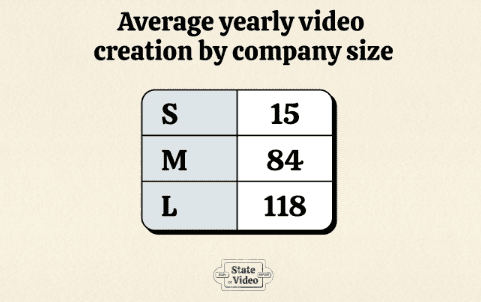
Source
68. Over 60% of businesses struggle to make videos because of time and bandwidth limitations. On the other hand, 43.5% are held back by technical, resource, and time constraints.
Affiliate SEO Stats
Affiliate marketing is when a business or person partners with another entity to promote their products or services and earn a commission for each sale made through their referral link. Here are a few statistics related to affiliate marketing and SEO.
69. 82% of websites that make more than 6 figures per year monetize through affiliate products and display ads.
70. Only 4 out of the 100 rankings on top of SERPs for product review search queries are non-affiliate, independent brands.
71. About a quarter of content creators in the US earn anywhere between $100 and $500 through social commerce affiliate programs.
Local SEO Stats
Local SEO means optimizing your online presence to attract more business from relevant local searches.
For example, if you own a restaurant in New York City, you would want your business to appear when someone searches for “restaurants in NYC” on Google. Local SEO is instrumental for small and medium-sized businesses that rely on local customers.
The following statistics shed more light on it.
72. About 81% of shoppers search for reviews of local businesses on Google.
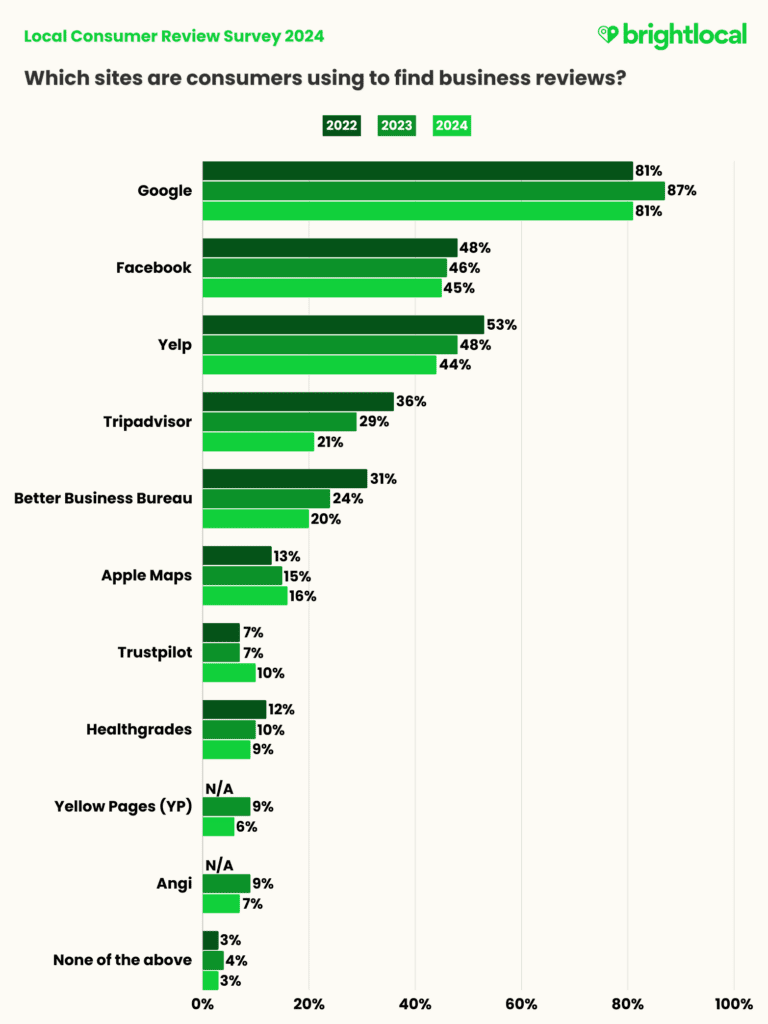
Source
73. A complete Google Business Profile is 70% more likely to get you visits from customers. Similarly, it increases the chance of customers making a purchase by 50%.
74. There has been a 100% year-over-year increase in the number of ”shopping near me” searches on Google Maps.
75. Businesses with a complete Google My Business profile have a 2.7 times higher chance of being deemed ”reputable” by customers.
76. 88% of consumers are likely to use a business’s product or service if they reply to all customer reviews.

Source
77. 28% of all local searches result in a purchase.
AI SEO Statistics
The advent of AI means that SEO will have to change. AI content writers can generate articles, making it harder to compete for top SERP positions. Here are some AI SEO statistics to make sense of what the future may hold.
78. Writing jobs have seen a decrease of 33% since the release of ChatGPT.
79. 85.1% of marketers use AI for some aspects or whole of article writing.
80. 89% of marketers who use generative AI to create content say that it improves the quality of their resulting content.
81. Keywords Everywhere reports that the search trend for topics related to use of AI in SEO has spiked in the past 12 months.

82. Over 65% of people believe that AI content is the same or better than human writing.
83. The value of AI use in marketing is expected to be over $107.5 billion by 2028.
84. About 44% of business leaders describe the return on investment (ROI) of their investment in AI to be somewhat positive, while 9% say it was very negative. On the other hand, 27% of business leaders believe it to be very positive.
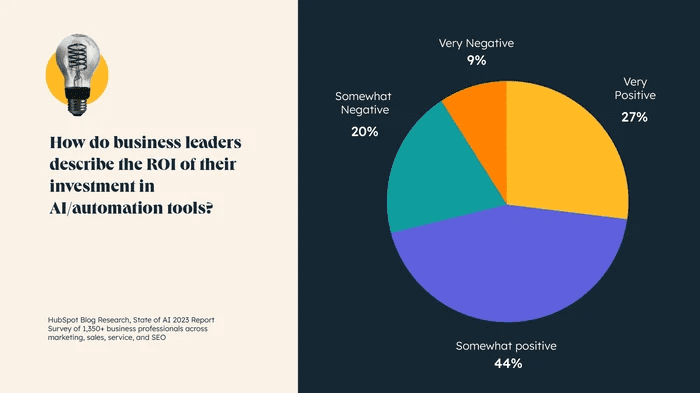
Source
85. 63% of people who use AI report inaccuracies as a major challenge in their use of this technology.
86. While 40% of marketers use AI to create full-fledged strategies, 70% use it for content creation and brainstorming ideas.
87. 48% of the top news websites in ten countries have blocked Open AI’s crawlers, and 24% of them have blocked Google’s AI crawler.
Conclusion
Sure enough, these are not all the SEO stats out there, but we’ve covered the most important ones that will give you a general understanding of the industry. From this list, it is clear that technical and local SEO are musts for businesses.
Similarly, having a backlink-building strategy is another imperative for search engine optimization. If we look at the future, short-form video content and AI adoption seem to be the trends that are likely to disrupt the SEO industry.
Understanding these trends and using them to your advantage can give you an edge over your competitors. While these trends change over time, the underlying themes of quality content and user experience will always remain important for SEO. So, make sure to stick to them.


